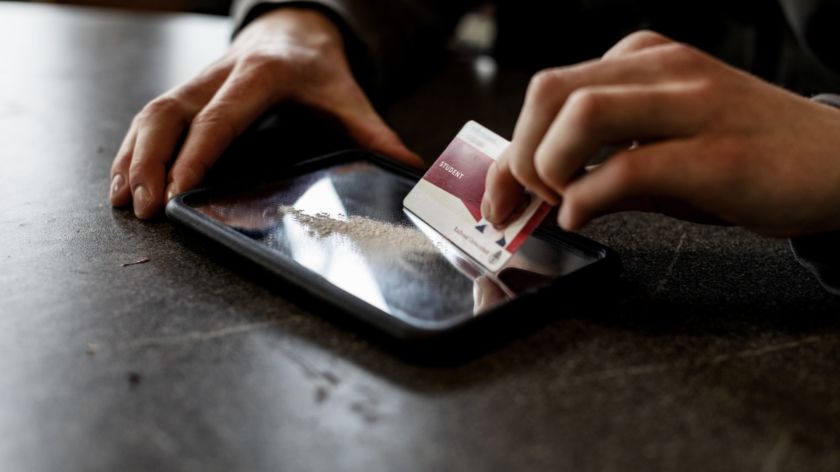It is difficult to predict how you will react to designer drugs
-
 Foto ter illustratie. Foto: Duncan de Fey
Foto ter illustratie. Foto: Duncan de Fey
In a few clicks, you can have them at your door: designer drugs. Most are even legal, too. In Nijmegen, as in the rest of the Netherlands, they are becoming increasingly mainstream among students. Utrecht researcher, Anne Zwartsen, warns: ‘Not very much is known about the effects of long-term use.’
Drinking a beer with your housemates or using ‘meow meow’. On this website students recently told us about their alcohol and drugs consumption during the coronavirus pandemic. In a survey by Vox one in ten students said that they sometimes take designer drugs (such as meow meow).
The number of students using these mind-altering substances has increased slightly during the pandemic – from 8 to 11%. By comparison, the use of MDMA (ecstasy) among Nijmegen students has dropped from 50 to 41%. How harmless are designer drugs? Anne Zwartsen (Utrecht University) has been researching this for four years.
Many designer drugs are legally available. Does that make them less dangerous than illegal drugs like cocaine and speed?
‘Not necessarily. Very little is known about the short or long term effects of these drugs, or how addictive they are. They have only been on the market since the beginning of the 21st century. An additional problem is that there are 900 different substances in circulation, and new ones are being added constantly. Some designer drugs like meow meow – also known as 4-MMC and mephedrone – are banned in the Netherlands. 3-MMC, which has a very similar chemical structure to meow meow, is also a designer drug, but it can be obtained legally. You do not know how addictive or harmful substances like 3-MMC are until they come on the market. Research into these drugs is usually only started when problems are reported by society.’
What have you tested in your research?
‘I have looked at the effects of 22 types of drugs on braincells and heart cells. This included well-known drugs like MDMA and cocaine, as well as designer drugs. A small change in the chemical structure of a substance can make a huge difference. For example, a substance reported to be very similar to MDMA can be much more harmful than MDMA itself. So when you take an identical dose of another substance, the effects can be a lot stronger.’
‘It’s a game of cat and mouse’
‘What I have often come across in the literature is that users react differently to the same drugs.’ That has to do with their DNA. Just like one person has blonde hair and another has black hair, person A may experience a different effect from a certain drug to person B. In the case of person A, it might break down sooner. So you cannot say: this pill had such-and-such an effect on my housemate, so it will also work the same for me.’
We saw, for example, that if you have a certain variant of a brain protein that transports dopamine, this can lead to intoxication or symptoms of poisoning. With this mutation, 21 times less cocaine was needed to get the same effect compared to a normal dopamine transporter protein. Differences in metabolising or transport can potentially lead to unintentional overdoses.’
Can you prevent unsafe use?
The difficulty with designer drugs is that they cannot be dealt with as a group. By the time a substance is put on the black list and banned, people in labs will already be making new chemical structures. It is a game of cat and mouse. Experiences are swapped online and new drugs come into circulation. You only know it is bad news when it is too late. For example, the party drugs 4-FA and 2C-B were very popular a few years ago. But after a few cases of poisoning – think brain haemorrhages and heart problems – these drugs were classified as hard drugs. Now they are listed as illegal.’
That does not mean that you cannot get hold of them. Nor does it mean that the drugs that have not been regulated yet are safe. Not enough research has yet been conducted into them. The government is now working to change the rules regarding these drugs so that larger groups of drugs can be regulated all at once, rather than on a drug-by-drug basis.’
Are you against the use of designer drugs?
‘I am not for drug use, but not against it either. Everyone has to decide that for themselves. I am just saying: weigh up the risks yourself and get your stuff tested before you use it. You never know what effect certain drugs will have on you, but you can at least check what is in them. I think that many young people fail to realise the danger of designer drugs because they are so easy to get hold of. I have ordered them online myself for my research. They were delivered to my home two days later. They have become very mainstream in recent years.’
Drug research Vox
In February, Vox enlisted over 3,000 randomly selected students with a Radboud University email address for a study on alcohol and drugs. 670 of them completed the anonymous survey. Drinking seems to have fallen substantially during the coronavirus pandemic. Two in five drug-users had reduced their intake. Simultaneously, the group of daily drug users doubled from 2.2 to 4.3%.
Weed was the most popular drug before the pandemic – 80% of the drug-users occasionally smoked joints. For MDMA, the usage rate was 50%, while one in five of the users had taken cocaine, laughing gas, ketamine or magic truffles. About one in ten students took designer drugs, like 3-MMC and 4-MMC.



